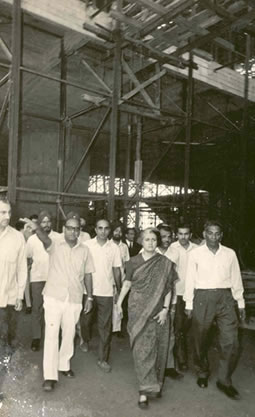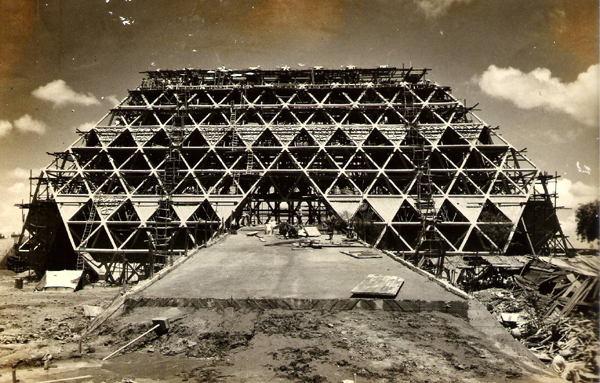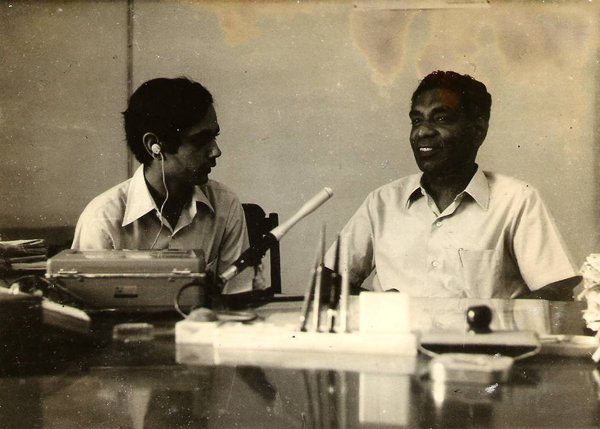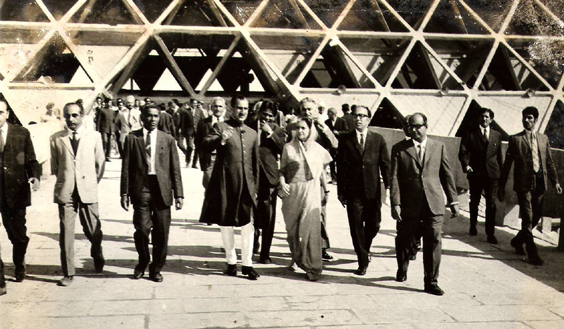|
Durai's Space |
|
Nation-building
With Prime Minister Indira Gandhi on her weekly visits
The Hall of Nations was the biggest space frame structure in concrete in the world with a height
of 108ft. It was built at Pragati Maidan when India for the very first time hosted the International Trade Fair "Asia '72".
Weekly TV and AIR broadcast by me during the construction of Asia 1972.
Mrs. Indra Gandhi, Prime Minister of India during one of her weekly visits to Pragati Maidan in 1972
when the work on Hall of Nations was nearing completion. 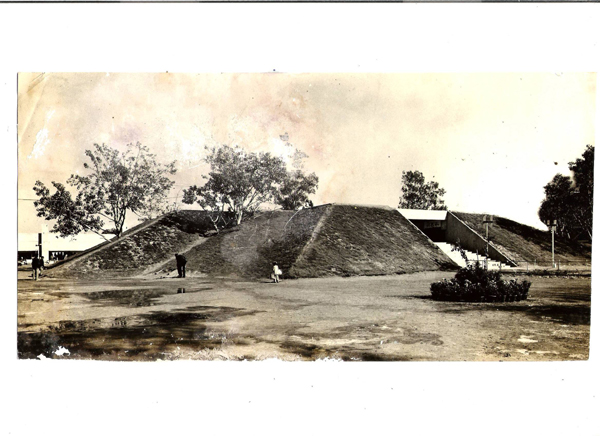 Construction of Nehru Pavilion at Pragati Maidan using 'No building concept'
for the first time in India. A three storeyed structure built underground and completed in 3 months in 1972 at the request of Mrs. Indra Gandhi, Prime Minister of India.
In November 1971, Government of India was planning to put
up an International Trade Fair at the Pragati Maidan, In addition, pavilions had to be built for: As usual, Government was late in planning such a major project and expected this work costing over Rs. 15 crores at the
then prevailing construction rates to be completed within just one year. Except for appointing
Mr. Mohammad Yunus as Chairman of the Trade Fair Authority and Mr. Ramadorai, Joint Secretary from the Ministry of Commerce
to oversee the project, no other arrangements had been made by the Ministry. They then started searching for a Chief
Engineer to take over the entire work and a competent Architect to plan out the whole project. The Ministry of Commerce however found out that I was also
a Chief Engineer and they sent for me to find out my willingness to undertake the work. In the meantime, they had also
contacted Mr. Raj Rewal, one of the best Architects in the country to prepare a layout of the whole area
showing the location of the various buildings to be constructed, roads, water and sewer lines, electrical installations,
open air auditorium, lake and the parking area and also an attractive design of the building to provide for a large display
area of 1.5 lakhs sq feet and smaller structures for the remaining areas of display. Space frame structure 108 feet high - the complicated structures designed by Mr. Raj
Rewal - the Hall of Nations and the Hall of Industries Needless to say, each one of these tasks was highly time-consuming
and complex. An impossible task: acomplished in prayer It looked at first an impossible task to accomplish. It
came as a challenge to me to discover whether I had the capacity and capability to undertake such a big venture within
such a short time, when all my co-Chief Engineers had backed out of this commitment. Needed in huge measure: hard work, skilled management
and parallel activity Immediate manpower requirement This would mean that the CPWD would have to immediately post
- the required number of engineers for supervision of the
work - more than number usually required because of the simultaneous execution of all the works, It took almost a month to clear the area of all the old buildings,
along with the deep and heavy foundations that some of them had and to level the area with the help of dozers and JCB’s..
Hummng with activity with simultaneous construction Personal site-visits by Prime Minister Indira
Gandhi, almost every week Black hair turns grey in 9 months with gruelling schedule: lunch at 4 pm, dinner
at 1 am, With the work in full swing, I had to change my usual routine
by having lunch at 4 pm every day, my dinner at 1 am and back at work at 8 am. My hair which was completely black at
the start of the project had turned grey by the time the project was over. It was a strain on me but I enjoyed
every bit of it to see that all my staff were fully cooperating with me, working hard and keeping up the time schedule
given to them. Skepticism that the Trade Fair would open on time About 3 months before the opening date of the Fair, our Prime
Minister approached me and requested me to design and put up an architecturally attractive structure to be named the
‘Nehru Pavilion’, where all the literature regarding our Freedom Movement leading to the independence of our country
and pictures of our freedom fighters could be displayed and where Gandhiji’s and Nehruji’s recorded
voices could be heard throughout the year. Just about a week before the opening date
when Ms Gandhi was at Bombay, she saw in the Times of India newspaper a picture of Pragati Maidan where they had
shown an open trench 20 feet deep in the midst of the Open Air Stadium with the remark that how they can
ever expect to open the Fair on the 14th November when that was the condition of the Fair grounds on that day.
Ms Gandhi got a little perturbed and rang up the Commerce Minister, Mr. A. C. George at Congratulations from scptics and well-wishers alike Additional responsibilities In that year, 47 foreign countries
took part in the Trade Fair along with 55 local private firms which put up their own pavilions and displayed their
products. The designs of their pavilions were also approved by me in respect of their water supply and electricity
requirements. With so many of them constantly worrying me with their respective problems, I was kept more than busy
in dealing patiently with their complaints in addition to fulfilling my main responsibilities in getting the project completed
in time. Extracts from some of their letters would show what I had to go through in dealing with them. Letter from Mahindra
and Geep Company dated the 30th October 1972. We cannot forget the patience with which you kept on solving
the repeated problems that arose and found solutions to all of them and let us add with admiration – never losing your
poise or equanimity in the process. On the various occasions that I have met you with my problems, I could not help but admire
the composure and readiness with which you were meeting and tackling the difficulties in spite of numerous calls for help
from the various other participants of the Exhibition. I am sure that it is this dedication in you and your able assistance
that has gone into making the Fair the pride it is bound to be, in such a short time. May we once again thank you and pray
that your services would be useful to the country in an ever increasing measure in the years to come. Letter from Merchandising
Officer, Trade Development Authority dated the 13th October 1972. This is to express my sincere thanks for the kind consideration
shown to us in getting the electricity connection at our site. I can only say that in you, there is a rare
blend of professional competence and human understanding and The completion of Extract from the letter
of a well-wisher addressed to Mr. Durai Raj dated the 31st October 1972. Advertisements are
appearing in the papers about the fact that the Prime Minister will declare the Fair open on 3rd November 1972.
I am so happy that in spite of the criticism that appeared in the press, you and your staff have
achieved the impossible. This was only because of the organization you brought into the planning and the hard
work and leadership you put in. This letter is to congratulate you on this splendid achievement and wish the Fair every success.
Following are extracts
from some of the Letters of appreciation received from the Departments of Government and from the Ministry of
the Government of From the Engineer-in-Chief,
Undoubtedly the efforts
put in for completing such a big work in a comparatively short time required extra-ordinary effort and it will be in the fitness
of things for Government to recognize the work of those who have rendered service beyond the call of duty.
The driving force behind the immense effort put in by the entire body of workers, supervisors and other officials towards
the completion of the Fair grounds and structures has no doubt been the Chief Engineer himself viz. Shri J. Durai Raj. But for the leadership, zeal and enthusiasm and the extra-ordinary labour put in by him, the staff working
under him would not have been inspired to put in all their efforts. It was his inspiring example which impelled them
to devote prolonged and continuous effort over a long period of many months. The example of hard work and devotion to duty
set by Shri Durai Raj without whose leadership, guidance and extra-ordinary devotion to duty, the job would not have been
completed in time, needs some recognition. He has earlier been awarded the title of Padma Shri for outstanding
work before and if approved, some higher title may be given to him as a recognition of his work for the Trade Fair.
If this is not possible, recognition may be given in some other shape as the Government deem fit. From Mr. Mohammad
Yunus, Chairman Trade Fair Authority dated the 5th March 1973 to the Secretary, Ministry of Works & Housing. I am writing this letter
to bring to the notice of the Government the outstanding services rendered by J. Durai Raj, Chief Engineer, Central Public
Works Department, during ASIA ’72. We had entrusted the
entire construction work to the CPWD. This vast and time-bound project consisting of highly sophisticated designs and complicated
structures had to be completed in record time. For instance, the Hall of Nations is the biggest space
frame structure in concrete in the world and will be a standing testimony to what we achieve in less than a year. J. Durai Raj with the characteristic boldness and organizing
ability, undertook all these construction works and supervised them with skill and devotion. It required hard work over a
protracted period of time and he toiled during day and night. Durai
Raj is already a PADMA SHRI. He has put in an outstanding piece of work for I would be grateful
if you would kindly arrange to communicate a special commendation of Government to Durai Raj for
his services during From the Secretary to the Ministry of Works & Housing
to Mr. Durai Raj on the 7th March 1973. I have great pleasure
in conveying the appreciation of the Government of On the night of 24th January 1973 when I was at
the Pragati Maidan site with my officers to ensure the smooth running of the Fair, Mr. A.C. George, Minister of Commerce turned
up and told me that his Ministry had recommended the award of Padma Shri to me for the splendid work carried out by me for
the ASIA ’72 International Trade Fair. I told him that I was already a Padma Shri awarded by the President of
India for the work carried out by me under the Ministry of External Affairs in NEFA. He said that his Ministry was not aware
of this and hence they had recommended the award of Padma Shri to me, to the Republic Day Award Committee It was by
then too late to make any change and the only thing that he could do at that stage was to get my name deleted from the Padma
Shri list. Anyway this will show that I was considered and recommended twice for the award of Padma Shri. General Manager, Hindustan Steelworks Construction Ltd. After the completion of the Trade Fair in April 1973, I was
offered the post of General Manager, Hindustan Steelworks Construction Ltd., a Public Sector Undertaking
under the Ministry of Steel with Headquarters at Until that time, I was mostly engaged in construction
of buildings including services, roads, runways and similar types of works. I was interested in enlarging my construction
experience by taking up industrial projects on a turnkey basis. I therefore accepted the offer and started
work from April 1973 onwards. ................................................................................................ Nation-building took on immense dimensions
in times when India was struggling to lift its head above the problems of disease, drought and famine, underdevelopment and
backwardness. It is the efforts of pioneers like Durai, that has set the country on a forward path in development, trade,
industry, food sufficiency and brought recognition for India in an increasingly globalised world. Read about
Durai's achievements at the website of the extended family, the Tucker family website. http://tuckerfamily1.tripod.com/Achievements/Durai.shtml |
